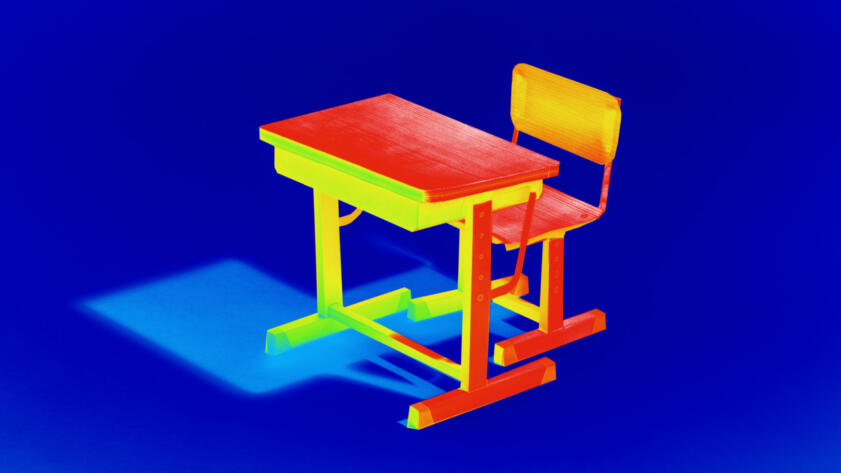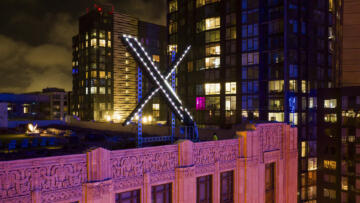Fayette County Public Schools, a 24-school district in Georgia, reopened its classroom doors last month. As at many schools around the country, officials in Fayette have concerns about safely bringing students back to school amid a pandemic—and they’re turning to surveillance technology for help.
The school district recently made a deal to purchase up to 75 cameras equipped with thermal imaging. The cameras, made by Hikvision, a Chinese provider of facial recognition tools and other surveillance equipment, cost $7,000 each and rapidly estimate temperatures to monitor potential viral spread on school grounds. The ability to quickly scan for a sign of the virus is an attractive option for schools, one that’s potentially faster and safer than manually taking each visitor’s temperature.
“The Hikvision cameras will only be used to measure an individual’s temperature to help eliminate the spread of COVID-19 and other viruses that may cause fever,” Melinda Berry-Dreisbach, a spokesperson for the district said in an email to The Markup.
The measure, she said, was a practical way to test for elevated temperature when students and staff enter a school. Berry-Dreisbach said the cameras will not be used for facial recognition or other automated identification purposes, and temperature readings will be stored on the school’s local network and eventually deleted.
Hikvision, like some other tech firms, is marketing its products directly to schools, while promoting “value-added choices,” like automated mask detection and face identification.
[Surveillance tools are] a costly distraction from evidence-based public health measures.
Albert Fox Cahn, Surveillance Technology Oversight Project
But is this surveillance technology useful at preventing an outbreak? Privacy advocates say no—and also worry that expensive technology installed during the pandemic could be used to track students long after it subsides.
Albert Fox Cahn, executive director of the Surveillance Technology Oversight Project and a host of the podcast “Surveillance and the City,” said the efficacy of temperature checks is far from proven and that infected people may be asymptomatic or presymptomatic.
Surveillance tools, he said, are “a costly distraction from evidence-based public health measures” like contact tracing and social distancing.
Fox Cahn says he understands the allure of the technologies for school districts.
“You have this situation where people are faced with impossible choices,” Fox Cahn said. “Either trying to provide education remotely or trying to invest huge sums in manual contact tracing and really restrictive measures.”
“Technology firms offer this seemingly incredible option,” he said. But for him, it’s just that—not credible.
Schools Have Long Flirted with Surveilling Students—but It Could Become Commonplace
Even before the COVID-19 pandemic, school districts were turning to surveillance technologies, often in the name of boosting campus security by tracking visitors or uncovering weapons or fighting truancy. One New York State school district began experimenting with facial recognition technology before state legislators hit pause on the program, and dozens of schools have started to use Bluetooth location tracking.
But the pandemic has brought a new wave of interest. The Wall Street Journal recently reported on an AI-powered Motorola service for detecting mask compliance on video. Other schools are giving students wearables for tracking whom they come in contact with, or offering COVID-screening apps.
Last month, TechCrunch reported that students at Albion College, a liberal arts school in Michigan, would be required to use a contact-tracing app. The app tracks students movements in real time. Using the app is mandatory during school hours, and students could face disciplinary action for not complying. (A “FAQ” sheet from Albion says officials will only use “location data for [contact] tracing in the event of a positive test.”)
Schools continuing remote learning also have a slate of surveillance technologies to purchase—including software that provides remote proctoring services, monitoring students as they take tests, or automatically tracking homework and attendance.
The Technology May Sound Useful but Can Be a “Blunt Tool”
Rachel Levinson-Waldman, deputy director of the Liberty and National Security Program at the Brennan Center for Justice, says software like location tracking can be “a pretty blunt tool”—not something that gives you the full picture.
An app that tells you whether you came within six feet of someone diagnosed with COVID-19 may not provide proper context—like if there was a wall or glass between you, she said. Similarly, the app might not be able to tell whether you were wearing a mask or face shield, or whether you were indoors or outdoors.
You’re getting into really sensitive issues if you’re identifying things like when are students in the bathroom….
Rachel Levinson-Waldman, Brennan Center for Justice
Cameras or tracking tools might also be installed during the pandemic, Levinson-Waldman said, but there’s no guarantee they won’t stay in schools far longer and wind up being used for something beyond their initial purposes. The technology could eventually be used to monitor for truancy or other disciplinary infractions, or even provide data to law enforcement.
Regardless of how the data is intended to be used, Levinson-Waldman said, the information collected can be extraordinarily personal.
“You’re getting into really sensitive issues if you’re identifying things like when are students in the bathroom, because that information gets more and more intimate,” she said.
A report released this month by the Surveillance Technology Oversight Project says any technologies adopted during pandemic school reopenings should take into account potential data hacking and other unforeseen uses of data, as well as students’ right to privacy from administrators, police, and even their parents.
“Persistent location monitoring of schoolchildren risks becoming yet another facet of the school-to-prison pipeline,” the report said, “providing law enforcement with unprecedented tracking capabilities for monitoring children of color.”
Some Schools Are Doing Without
There are schools focusing their efforts on more traditional testing and tracing methods. Duke University, for example, uses a “pool-testing” system that involves testing five samples at once. Other colleges have taken a similar approach.
At the University of Arizona, college officials are testing dorm wastewater for signs of the virus and say they recently prevented a larger outbreak through the process. After a water sample from one dorm came back positive for the virus in August, officials tested everyone in the building and found two infected students who were then quarantined.
Persistent location monitoring of schoolchildren risks becoming yet another facet of the school-to-prison pipeline….
Surveillance Technology Oversight Project report
Public schools in New York City plan to randomly test 10 percent of students and teachers to monitor for the virus as schools reopen. In Los Angeles, school officials announced a plan last month to test 700,000 students in the coming months.
But those programs take substantial money and resources—making them, without additional federal help, out of reach for many schools.
There’s a need for “a national investment in effective contact tracing by culturally competent contact tracers from the community,” and to have them specially trained for working with kids, Fox Cahn, of the Surveillance Technology Oversight Project, said.
Ultimately, he said, he trusts the humans to prevent outbreaks more than the machines.
“All of the questions that a well-trained contact tracer would ask to identify someone’s potential risk of exposure are missing from these sorts of mass tracking systems,” he said.





